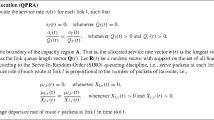Abstract
Enabling multipacket reception (MPR) at the physical layer is a promising way to achieve higher bandwidth efficiency while reducing the complexity of the medium access control layer in distributed wireless networks. We study distributed probabilistic access where transmitting nodes access the shared wireless medium with a probability based on the node’s information about the aggregate traffic carried by the network. We model bursty traffic by rate-controlled two-state Markov sources and introduce a parameter that describes the “burstiness” level of the offered traffic. A throughput-optimal medium access strategy utilizing limited feedback is then described and its performance is examined for traffic with different levels of burstiness. It is shown that the bursty nature of the traffic in data networks allows for improvement of the bandwidth efficiency. Bounds on the system throughput are proposed and the queuing delay is analyzed.










Similar content being viewed by others
Notes
In this paper, throughput is measured in packets per slot duration.
The normalized throughput can be thought of as a measure of bandwidth efficiency if the maximum load that the multiuser detection handles is fixed, i.e., if the required bandwidth per packet increases proportionally to K.
Generalization of the algorithm to cases of less frequent feedback is straight-forward.
Poisson traffic with average rate λ is equivalent to the case of M→∞ and α=1−δ=λ/M.
The reason why these values do not act as exact bounds is the slight difference between short-term-optimal and long-term-optimal selections of p explained earlier.
References
Abramson, N. (1970). The aloha system—another alternative for computer communications. In Proc. fall joint comput. conf, Houston, TX.
Abramson, N. (1977). The throughput of packet broadcasting channels. IEEE Transactions on Communications, COM-25(1), 117–128.
Adas, A. (1997). Traffic models in broadband networks. IEEE Communications Magazine, 35(7), 82–89.
Baum, L. E., Petrie, T., Soules, G., & Weiss, N. (1970). A maximization technique occurring in the statistical analysis of probabilistic functions of Markov chains. The Annals of Mathematical Statistics, 41(1), 164–171.
Ghanbarinejad, M., & Schlegel, C. (2010). Controlled random access with multipacket reception and traffic uncertainty. In Proc. IEEE Globecom’10 workshops, Miami, FL.
Ghanbarinejad, M., & Schlegel, C. (2011). Analysis of controlled probabilistic access with multipacket reception. In Proc. IEEE Globecom’11, Houston, TX.
Ghanbarinejad, M., & Schlegel, C. (2011). Throughput-optimal distributed probabilistic medium-access in mpr-capable networks. In C. Sacchi et al. (Eds.), Lecture notes in computer science: Vol. 6886. Multiple access comm (pp. 75–86). Berlin: Springer.
Ghanbarinejad, M., Schlegel, C., & Gburzynski, P. (2009). Adaptive probabilistic medium access in mpr-capable ad-hoc wireless networks. In Proc. IEEE Globecom’09, Honolulu, HI.
Kleinrock, L., & Tobagi, F. A. (1975). Packet switching in radio channels: part I—carrier sense multiple-access modes and their throughput-delay characteristics. IEEE Transactions on Communications, COM-23(12), 1400–1416.
Kumar, A., & Patil, D. (1997). Stability and throughput analysis of unslotted cdma-aloha with finite number of users and code sharing. Telecommunications Systems, 8(2–4), 257–275.
Lagkas, T. D., Stratogiannis, D. G., & Chatzimisios, P. (2011). Modeling and performance analysis of an alternative to IEEE 802.11e hybrid control function. Telecommunications Systems doi:10.1007/s11235-011-9477-5.
Molle, M. L., & Christensen, K. J. (1998). The effects of controlling capture on multimedia traffic for shared ethernet systems. Telecommunications Systems, 9(3–4), 287–314.
Monahan, G. E. (1982). A survey of partially observable Markov decision processes: theory, models, and algorithms. Management Science, 28(1), 1–16.
Nagaraj, S., Truhachev, D., & Schlegel, C. (2008). Analysis of a random channel access scheme with multi-packet reception. In Proc. IEEE Globecom’08, New Orleans, LA.
Puterman, M. L. (1994). Markov decision processes: discrete stochastic dynamic programming. Hoboken: Wiley.
Tobagi, F. A. (1980). Analysis of a two-hop centralized packet radio network—part I: slotted aloha. IEEE Transactions on Communications, COM-28(2), 196–207.
Ware, C., Judge, J., Chicharo, J., & Dutkiewicz, E. (2000). Unfairness and capture behaviour in 802.11 adhoc networks. In Proc. IEEE intl. conf. comm. (ICC), New Orleans, LA.
Author information
Authors and Affiliations
Corresponding author
Appendix
Appendix
Proof of Proposition 1
First, we show that the following sequence
converges to
Define
It follows that any subsequence of ξ N arbitrarily close to \(\lambda _{K}^{*}+l_{K}\) is an infinite sequence, i.e., the subsequence indexed by
is infinite for any ε>0. Therefore, the subsequence converges to \(\lambda_{K}^{*}+l_{K}\) as ε→0+. It follows that the distribution of N Bernoulli trials with probability \(p_{K}^{*}(N)\) can arbitrarily approach a Poisson distribution with mean \(\lambda _{K}^{*}+l_{K}\) with sufficiently small ε>0. This distribution is asymptotically suboptimal unless l K =0 (following the definition of \(\lambda_{K}^{*}\)). Since the optimality of \(p_{K}^{*}\) must result in the asymptotic optimality of ξ N and all its subsequences, we have l K =0.
As a result, we have
where the second and the last equality hold because the CDF of the Poisson distribution at any finite value tends to zero as its mean goes to infinity. This means that the asymptotic distribution of the number of transmitted packets with GAPA follows a Poisson distribution with mean \(\lambda_{K}^{*}\) as λ→∞. Therefore, the system performs as if the aggregate offered traffic was Poisson with mean \(\lambda_{K}^{*}\) and Aloha was used. □
Rights and permissions
About this article
Cite this article
Ghanbarinejad, M., Schlegel, C. Distributed probabilistic medium access with multipacket reception and Markovian traffic. Telecommun Syst 56, 311–321 (2014). https://doi.org/10.1007/s11235-013-9838-3
Published:
Issue Date:
DOI: https://doi.org/10.1007/s11235-013-9838-3




